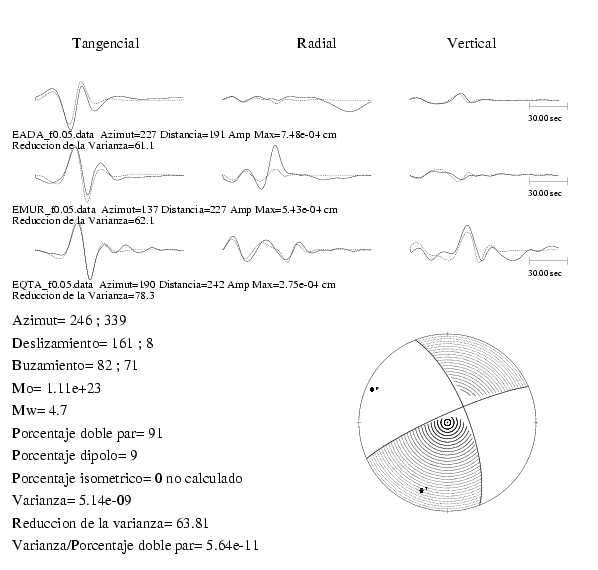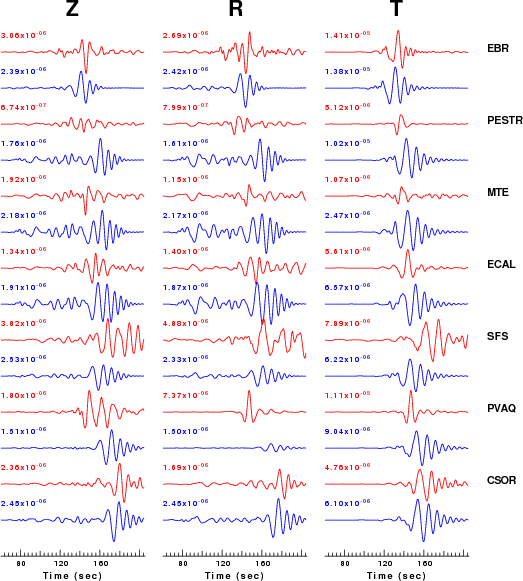Location
2007/08/12 07:47:05 39.36N -2.95.01W 5 4.7 Spain
Arrival Times (from USGS)
Arrival time list
Felt Map
USGS Felt map for this earthquake
USGS Felt reports page for Spain
Focal Mechanism
SLU Moment Tensor Solution
2007/08/12 07:47:05 39.36N -2.95.01W 5 4.7 Spain
Best Fitting Double Couple
Mo = 9.02e+22 dyne-cm
Mw = 4.57
Z = 12 km
Plane Strike Dip Rake
NP1 66 76 164
NP2 160 75 15
Principal Axes:
Axis Value Plunge Azimuth
T 9.02e+22 21 23
N 0.00e+00 69 204
P -9.02e+22 0 113
Moment Tensor: (dyne-cm)
Component Value
Mxx 5.27e+22
Mxy 6.07e+22
Mxz 2.81e+22
Myy -6.44e+22
Myz 1.13e+22
Mzz 1.17e+22
##############
----############ ###
-------############ T ######
--------############ #######
----------########################
-----------#########################
-------------#########################
--------------#######################---
---------------####################-----
----------------##################--------
-----------------##############-----------
-----------------###########--------------
------------------######------------------
------------------#---------------------
-------------#####-------------------
----##############------------------ P
##################-----------------
##################----------------
#################-------------
##################----------
################------
##############
Harvard Convention
Moment Tensor:
R T F
1.17e+22 2.81e+22 -1.13e+22
2.81e+22 5.27e+22 -6.07e+22
-1.13e+22 -6.07e+22 -6.44e+22
Details of the solution is found at
http://www.eas.slu.edu/Earthquake_Center/MECH.EU/20070812074705/index.html
|
IGN (Madrid) Solution http://www.ign.es/ign/home/geofisica/sismologia/principalTensorUltimo.jsp?registros=91&inicio=1&fin=0&i=90
Evid Fecha Hora Latitud Longitud Prof Mw Localización
780720 12/08/2007 07:47:05 39.357 -2.986 9 4.7 SW PEDRO MUQOZ.CR

|
Preferred Solution
The preferred solution from an analysis of the surface-wave spectral amplitude radiation pattern, waveform inversion and first motion observations is
STK = 160
DIP = 75
RAKE = 15
MW = 4.57
HS = 12
The waveform inversion is preferred.
Waveform Inversion
The focal mechanism was determined using broadband seismic waveforms. The location of the event and the
and stations used for the waveform inversion are shown in the next figure.

|
|
Location of broadband stations used for waveform inversion
|
The program wvfgrd96 was used with good traces observed at short distance to determine the focal mechanism, depth and seismic moment. This technique requires a high quality signal and well determined velocity model for the Green functions. To the extent that these are the quality data, this type of mechanism should be preferred over the radiation pattern technique which requires the separate step of defining the pressure and tension quadrants and the correct strike.
The observed and predicted traces are filtered using the following gsac commands:
hp c 0.02 n 4
lp c 0.10 n 4
The results of this grid search from 0.5 to 19 km depth are as follow:
DEPTH STK DIP RAKE MW FIT
WVFGRD96 0.5 250 65 35 4.29 0.2643
WVFGRD96 1.0 255 55 35 4.33 0.2734
WVFGRD96 2.0 255 60 35 4.38 0.2986
WVFGRD96 3.0 260 55 40 4.43 0.3050
WVFGRD96 4.0 160 80 20 4.39 0.3006
WVFGRD96 5.0 160 75 20 4.42 0.3143
WVFGRD96 6.0 160 70 20 4.44 0.3268
WVFGRD96 7.0 160 70 15 4.47 0.3388
WVFGRD96 8.0 160 70 20 4.51 0.3497
WVFGRD96 9.0 160 70 15 4.53 0.3582
WVFGRD96 10.0 160 75 15 4.54 0.3641
WVFGRD96 11.0 160 75 15 4.56 0.3673
WVFGRD96 12.0 160 75 15 4.57 0.3683
WVFGRD96 13.0 155 80 15 4.58 0.3676
WVFGRD96 14.0 160 80 10 4.60 0.3650
WVFGRD96 15.0 340 80 10 4.62 0.3616
WVFGRD96 16.0 340 80 10 4.63 0.3577
WVFGRD96 17.0 340 80 10 4.64 0.3520
WVFGRD96 18.0 340 80 10 4.65 0.3448
WVFGRD96 19.0 340 80 10 4.66 0.3365
WVFGRD96 20.0 340 80 10 4.67 0.3265
WVFGRD96 21.0 340 80 10 4.67 0.3156
WVFGRD96 22.0 340 80 10 4.68 0.3037
WVFGRD96 23.0 340 80 10 4.68 0.2923
WVFGRD96 24.0 340 80 10 4.69 0.2807
WVFGRD96 25.0 340 80 10 4.69 0.2682
WVFGRD96 26.0 340 85 10 4.69 0.2560
WVFGRD96 27.0 340 90 15 4.69 0.2440
WVFGRD96 28.0 155 40 -20 4.73 0.2396
WVFGRD96 29.0 160 40 -15 4.74 0.2353
The best solution is
WVFGRD96 12.0 160 75 15 4.57 0.3683
The mechanism correspond to the best fit is

|
|
Figure 1. Waveform inversion focal mechanism
|
The best fit as a function of depth is given in the following figure:

|
|
Figure 2. Depth sensitivity for waveform mechanism
|
The comparison of the observed and predicted waveforms is given in the next figure. The red traces are the observed and the blue are the predicted.
Each observed-predicted componnet is plotted to the same scale and peak amplitudes are indicated by the numbers to the left of each trace. The number in black at the rightr of each predicted traces it the time shift required for maximum correlation between the observed and predicted traces. This time shift is required because the synthetics are not computed at exactly the same distance as the observed and because the velocity model used in the predictions may not be perfect.
A positive time shift indicates that the prediction is too fast and should be delayed to match the observed trace (shift to the right in this figure). A negative value indicates that the prediction is too slow.
The bandpass filter used in the processing and for the display was
hp c 0.02 n 4
lp c 0.10 n 4

|
|
Figure 3. Waveform comparison for depth of 8 km
|

|
|
Focal mechanism sensitivity at the preferred depth. The red color indicates a very good fit to thewavefroms.
Each solution is plotted as a vector at a given value of strike and dip with the angle of the vector representing the rake angle, measured, with respect to the upward vertical (N) in the figure.
|
Surface-Wave Focal Mechanism
The following figure shows the stations used in the grid search for the best focal mechanism to fit the surface-wave spectral amplitudes of the Love and Rayleigh waves.

|
|
Location of broadband stations used to obtain focal mechanism from surface-wave spectral amplitudes
|
The surface-wave determined focal mechanism is shown here.
NODAL PLANES
STK= 67.38
DIP= 80.34
RAKE= 164.78
OR
STK= 159.99
DIP= 75.00
RAKE= 10.00
DEPTH = 11.0 km
Mw = 4.75
Best Fit 0.8134 - P-T axis plot gives solutions with FIT greater than FIT90
First motion data
The P-wave first motion data for focal mechanism studies are as follow:
Sta Az(deg) Dist(km) First motion
Surface-wave analysis
Surface wave analysis was performed using codes from
Computer Programs in Seismology, specifically the
multiple filter analysis program do_mft and the surface-wave
radiation pattern search program srfgrd96.
Data preparation
Digital data were collected, instrument response removed and traces converted
to Z, R an T components. Multiple filter analysis was applied to the Z and T traces to obtain the Rayleigh- and Love-wave spectral amplitudes, respectively.
These were input to the search program which examined all depths between 1 and 25 km
and all possible mechanisms.

|
|
Best mechanism fit as a function of depth. The preferred depth is given above. Lower hemisphere projection
|

|
|
Pressure-tension axis trends. Since the surface-wave spectra search does not distinguish between P and T axes and since there is a 180 ambiguity in strike, all possible P and T axes are plotted. First motion data and waveforms will be used to select the preferred mechanism. The purpose of this plot is to provide an idea of the
possible range of solutions. The P and T-axes for all mechanisms with goodness of fit greater than 0.9 FITMAX (above) are plotted here.
|

|
|
Focal mechanism sensitivity at the preferred depth. The red color indicates a very good fit to the Love and Rayleigh wave radiation patterns.
Each solution is plotted as a vector at a given value of strike and dip with the angle of the vector representing the rake angle, measured, with respect to the upward vertical (N) in the figure. Because of the symmetry of the spectral amplitude rediation patterns, only strikes from 0-180 degrees are sampled.
|
Love-wave radiation patterns
Rayleigh-wave radiation patterns
Broadband station distribution
The distribution of broadband stations with azimuth and distance is
Sta Az(deg) Dist(km)
EBR 60 335
PESTR 264 405
MTE 288 410
ECAL 313 430
SFS 223 430
PVAQ 244 470
CSOR 44 480
EJON 53 599
MAHO 82 622
ARBF 54 830
RUSF 51 867
SSB 41 901
OGDI 52 927
CALF 56 956
ANTI 58 961
ESCA 57 993
SAOF 56 1013
GIMEL 40 1094
EMV 44 1097
AIGLE 43 1120
DIX 45 1129
BRANT 39 1137
SENIN 44 1141
MMK 47 1161
BOURR 39 1214
HASLI 44 1220
MUGIO 50 1222
FUSIO 46 1231
MUO 44 1264
LLS 46 1278
VDL 48 1282
ZUR 43 1288
HTL 355 1298
PLONS 46 1314
BERNI 49 1315
DAVOX 48 1328
LIENZ 45 1337
FUORN 49 1343
BFO 38 1345
WLF 29 1352
DAVA 46 1360
HGN 26 1445
WTTA 49 1470
FUR 45 1502
Waveform comparison for this mechanism
Since the analysis of the surface-wave radiation patterns uses only spectral
amplitudes and because the surfave-wave radiation patterns have a 180 degree symmetry, each surface-wave solution consists of four possible focal mechanisms corresponding to the interchange of the P- and T-axes and a roation of the mechanism by 180 degrees. To select one mechanism, P-wave first motion can be used. This was not possible in this case because all the P-wave first motions were
emergent ( a feature of the P-wave wave takeoff angle, the station location and the mechanism). The other way to select among the mechanisms is to compute
forward synthetics and compare the observed and predicted waveforms.
The fits to the waveforms with the given mechanism are show below:
This figure shows the fit to the three components of motion (Z - vertical, R-radial and T - transverse). For each station and component, the
observed traces is shown in red and the model predicted trace in blue. The traces represent filtered ground velocity in units of meters/sec (the peak value is printed adjacent to each trace; each pair of traces to plotted to the same scale to emphasize the difference in levels). Both synthetic and observed traces have been filtered using the SAC commands:
hp c 0.02 n 4
lp c 0.10 n 4
Discussion
The Future
Should the national backbone of the
USGS Advanced National Seismic System (ANSS)
be implemented with an interstation separation of 300 km, it is very likely that
an earthquake such as this would have been recorded at distances on the order of
100-200 km. This means that the closest station would have information on
source depth and mechanism that was lacking here.
Acknowledgements
Dr. Harley Benz, USGS, provided the USGS USNSN digital data.
The digital data used in this study were provided by Natural Resources Canada through their AUTODRM site http://www.seismo.nrcan.gc.ca/nwfa/autodrm/autodrm_req_e.php, and IRIS using their BUD interface
Appendix A
Spectra fit plots to each station
Velocity Model
The WUS used for the waveform synthetic seismograms and for the surface wave eigenfunctions and dispersion is as follows:
MODEL.01
Model after 8 iterations
ISOTROPIC
KGS
FLAT EARTH
1-D
CONSTANT VELOCITY
LINE08
LINE09
LINE10
LINE11
H(KM) VP(KM/S) VS(KM/S) RHO(GM/CC) QP QS ETAP ETAS FREFP FREFS
1.9000 3.4065 2.0089 2.2150 0.302E-02 0.679E-02 0.00 0.00 1.00 1.00
6.1000 5.5445 3.2953 2.6089 0.349E-02 0.784E-02 0.00 0.00 1.00 1.00
13.0000 6.2708 3.7396 2.7812 0.212E-02 0.476E-02 0.00 0.00 1.00 1.00
19.0000 6.4075 3.7680 2.8223 0.111E-02 0.249E-02 0.00 0.00 1.00 1.00
0.0000 7.9000 4.6200 3.2760 0.164E-10 0.370E-10 0.00 0.00 1.00 1.00
Quality Control
Here we tabulate the reasons for not using certain digital data sets
The following stations did not have a valid response files:
DATE=Thu Aug 16 08:34:04 CDT 2007
Last Changed 2007/08/12













